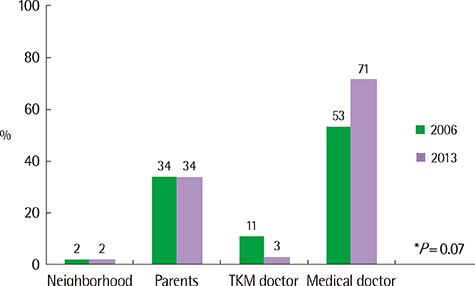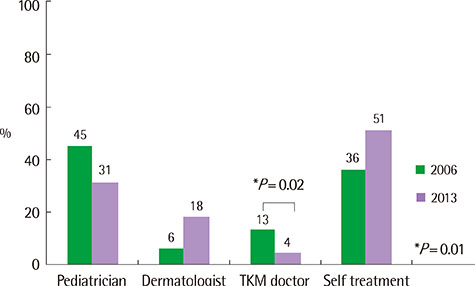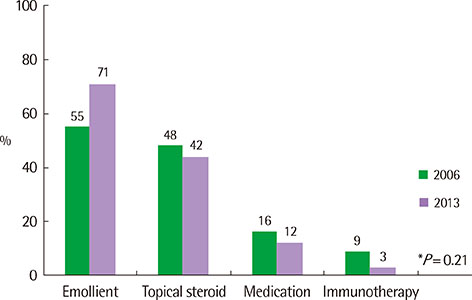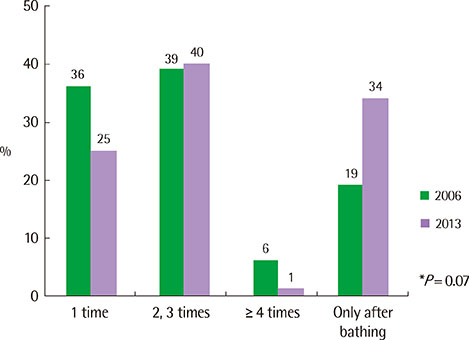Allergy Asthma Respir Dis.
2014 May;2(2):122-127. 10.4168/aard.2014.2.2.122.
Changing Caregivers' awareness on atopic dermatitis
- Affiliations
-
- 1Department of Pediatrics, Kyung Hee University School of Medicine, Seoul, Korea. chsh0414@naver.com
- KMID: 2261747
- DOI: http://doi.org/10.4168/aard.2014.2.2.122
Abstract
- PURPOSE
The objective of this study investigates the change in the awareness of the caregivers of atopic dermatitis (AD)' children, through questionnaires conducted in 2006 and 2013.
METHODS
A questionnaire of 15 items about the diagnosis and management of AD was done to survey a total of 146 caregivers participating in Atopy Friendly School Program in Dongdaemun-gu, Seoul, 2013. A comparison analysis was used to compare the results of the surveys conducted in 2006 and 2013.
RESULTS
Diagnosis of AD by doctor has increased while that by traditional Korean medical (TKM) doctor has decreased, but it was not statistically significant (P=0.07). Self-treatment has increased while the treatment by doctor remained similar. Treatment by TKM doctor has decreased. Overall change in medical institutions was statistically significant (P=0.01). The use of emollient has significantly increased while the use of topical steroid and oral medication has decreased with no statistically significant difference. Food restriction has significantly decreased (P=0.00), but it is still recognized as an important treatment option in 2013. As for the frequency of the emollient use, using it once a day has decreased whereas using it 2-3 times a day has increased, but there was no statistically significant difference.
CONCLUSION
Caregivers' awareness on AD has improved through 2006 to 2013 with the education provided by academic societies and government, but the accurate understanding of the disease still needs improvement. The future education should focus on the selection of appropriate healthcare services as well as the specific self-management strategies.
Keyword
MeSH Terms
Figure
Reference
-
1. Cho J, Lee JH, Suh J, Yu JS, Lee H, Park E, et al. Change in quality of life according to the change in atopic dermatitis severity. Pediatr Allergy Respir Dis. 2012; 22:86–99.
Article2. Lee JB, Rha YH, Choi SH. A questionnaire survey of Care-givers' understanding of atopic dermatitis. Korean J Asthma Allergy Clin Immunol. 2009; 29:179–185.3. Williams H, Robertson C, Stewart A, Ait-Khaled N, Anabwani G, Anderson R, et al. Worldwide variations in the prevalence of symptoms of atopic eczema in the International Study of Asthma and Allergies in Childhood. J Allergy Clin Immunol. 1999; 103:125–138.
Article4. Korea Centers for Disease Control and Prevention. The fifth Korea National Health and Nutrition Examination Survey (KNHANES V-3) 2012. Cheongwon: Korea Centers for Disease Control and Prevention;2012.5. Kim HY, Kwon EB, Baek JH, Shin YH, Yum HY, Jee HM, et al. Prevalence and comorbidity of allergic diseases in preschool children. Korean J Pediatr. 2013; 56:338–342.
Article6. Hong SJ, Ahn KM, Lee SY, Kim KE. The prevalences of asthma and allergic diseases in Korean children. Pediatr Allergy Respir Dis. 2008; 18:15–25.
Article7. Kwon HJ. The actual condition and epidemiologic study of Atopic diseases. General report. Seoul: Seoul Metropolitan Government;Atopy Environmental and Health Research Institute;2008.8. Oh JW. Recent situation of the management of atopic dermatitis. Korean J Asthma Allergy Clin Immunol. 2012; 32:14–15.9. Yum HY, Han KO, Park JA, Kang MY, Chang SI, Cho SH, et al. Improvement in disease knowledge through an education program of atopic dermatitis. Korean J Asthma Allergy Clin Immunol. 2012; 32:21–25.10. Nicol NH, Boguniewicz M. Successful strategies in atopic dermatitis management. Dermatol Nurs. 2008; Suppl. 3–18.11. Ministry of Health and Welfare. Annual report 2011. Seoul: Ministry of Health and Welfare;2012.12. Jo EJ, Kim MY, Jeon Y, Kwon JW, Na JI, Kim SH, et al. Educational demand on allergic diseases from 45 public health centers in Gyeonggi-do. Allergy Asthma Respir Dis. 2013; 1:55–59.
Article13. Korea Centers for Disease Control and Prevention. Epidemiology and management of atopy and asthma for prevention in the community. Seoul: Korea Centers for Disease Control and Prevention;2008.14. Stalder JF, Bernier C, Ball A, De Raeve L, Gieler U, Deleuran M, et al. Therapeutic patient education in atopic dermatitis: worldwide experiences. Pediatr Dermatol. 2013; 30:329–334.
Article15. Ahn K. Education effect of camp program for atopic dermatitis. Pediatr Allergy Respir Dis. 2012; 22:127–128.
Article16. Kim DH, Li K, Seo SJ, Jo SJ, Yim HW, Kim CM, et al. A survey on understanding of atopic dermatitis among Korean patients. Korean J Dermatol. 2012; 50:201–211.17. Cho JK. Survey for utilization of oriental medical services and comsumption of oriental medicine. Final report. Seoul: Ministry of Health and Welfare;2011. 11. Report No.:2011-48.18. Kim JK, Kim JH, Lim DH, Son BK. Qualitative assessment of atopic dermatitis-related websites. Pediatr Allergy Respir Dis. 2007; 17:282–288.19. Korea Institute for Health and Social Affairs. Awareness and utilization of Korea traditional medicine of the Korean. Issue Focus. 2012; 21:1–8.20. Arshad SH, Tariq SM, Matthews S, Hakim E. Sensitization to common allergens and its association with allergic disorders at age 4 years: a whole population birth cohort study. Pediatrics. 2001; 108:E33.
Article21. Chung EH. Development of comprehensive management plan for prevention & control of atopy asthma diseases (2012-2016). Final report. Cheongwon: Korea Centers for Disease Control and Prevention;2012. 04. Contract No.: 2011E3303000.22. Kim TY. Treatment of atopic dermatitis: an update and review of the literature. Pediatr Allergy Respir Dis. 2009; 19:209–219.
- Full Text Links
- Actions
-
Cited
- CITED
-
- Close
- Share
- Similar articles
-
- Measurement of Atopic Dermatitis Disability
- Serum IgE Level in Patients of Atopic Dermatitis and Atopic Dermatitis with Molluscum Contagiosum
- Nipple Involvement in Atopic Dermatitis: Report of 3 cases
- Two Cases of Atopic Dermatitis Developing Ocular Complication and Immunological Disturbance
- Concurrence of Atopic Dermatitis and Psoriasis







